

How is an electromagnetic field created?
It requires the simultaneous presence of an electric field created by electric charges and a magnetic field created by the flow of these charges.
A wave corresponds to the propagation of a disturbance that reversibly alters the physical properties of the environment in which it propagates. It transports energy without transporting matter. A wave exists only if there is a variation in a disturbance. Electromagnetic waves do not need a physical medium to propagate. They can propagate in the vacuum, unlike mechanical waves, which need a material medium.
Frequency, represented by f, is used to characterize periodic signals over the duration. The unit of frequency in the international system (SI) is the hertz (Hz). The period, represented by T, is the inverse of the frequency, the smallest interval of time after which an identical event recurs. The unit of the period is the second (s). Figure 3-1 represents the time profile of a sinusoidal electromagnetic field.
The science of telecommunications (television broadcasting, telephony, radar, etc.) aims to optimize the propagation of electromagnetic waves (or electromagnetic fields), i.e. to ensure service coverage across a particular area, with a minimum quality. The spread of waves beyond a limited area remains an undesirable effect for applications outside of telecommunications. The basic concepts of electromagnetic wave propagation are important for predicting the ambient electromagnetic field level, regardless of the application. So that waves can propagate across significant distances in relation to wavelength, we have seen there must be simultaneous creation of an electric field E and a magnetic field H. In the absence of one of the two elements, the field remains confined near to the source
The spectrum of Electromagnetic Field
In physics, electromagnetic fields range from static fields to infinite frequency fields. These radiations are distributed into two large groups, depending on their fundamental effects on the matter:
– ionizing radiations are located in the domain of Nano-metric wavelengths. They are able to break the atomic bonds of molecules or to eject one or several electrons from an atom to create positively charged particles (ions). These radiations have the highest frequencies (the modification of the structure of an atomic nucleus is part of nuclear physics).
– non-ionizing radiations cannot produce such effects.
Non-ionizing radiations begin at zero hertz, although strictly speaking, radiation and propagation do not occur since the field remains confined to the immediate vicinity of the source. This radiation domain ends with far UV rays.
The natural world, including your body, produces electromagnetic fields. But these fields are low in intensity. The technology produces much more intense electromagnetic fields, and these fields can cause health risks. You cannot see or hear them. But if you live where there is cell phone service or power lines, for example, you are exposed to artificial EMFs. Bioelectrical signals help to regulate many processes of the human body. In fact, science suggests that every cell in your body might have its own EMF.
However, strong artificial EMFs can enter your body and interfere with the natural way your body works. This can affect virtually any system within your body, from your sleep cycles to your stress levels to your immunities to your DNA.
